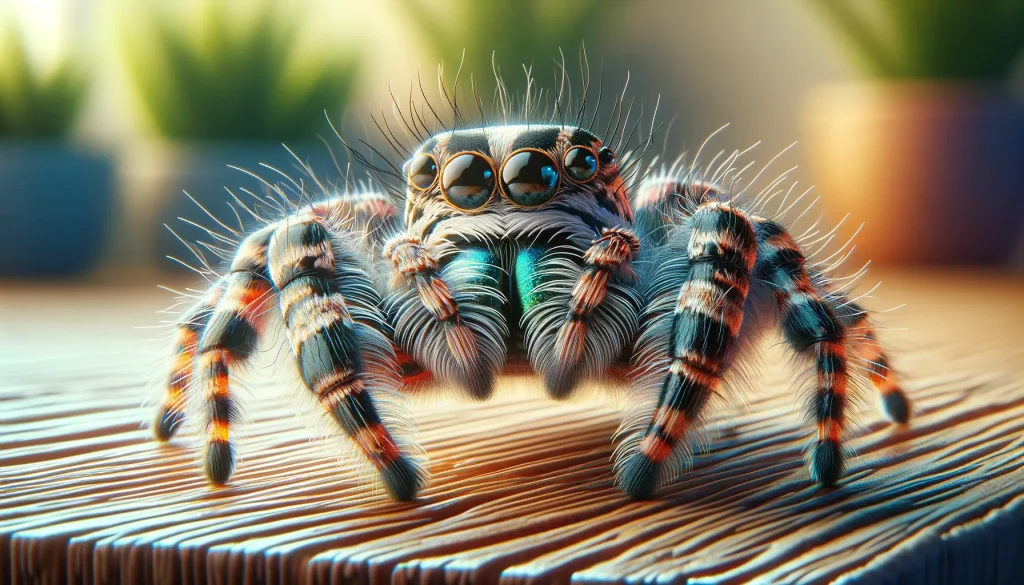
Care for Jumping Spider
Thinking about adding a jumping spider to your family? These compact, yet fascinating creatures have garnered a passionate following among pet enthusiasts for good reasons. They’re not only intelligent but remarkably low maintenance. In this article, we’ll dive into everything you need to know to keep your eight-legged friend happy and healthy. From setup to feeding, and even some fun facts, you’re in for a treat!
Jumping spiders, known for their remarkable hunting skills and charismatic personalities, have a wide array of species. Despite their size, they are incredibly agile and known for their unique way of moving around, which resembles jumping. Before we venture into the specifics of their care, it’s essential to understand that these creatures require a particular environment to thrive. But fear not, creating a comfortable habitat for them is easier than you might think, and the rewards of keeping such an intriguing pet are manifold.

Social Life of Jumping Spiders
While jumping spiders are often thought of as solitary creatures, they do exhibit interesting social behaviors. Understanding these can enhance how you care for them.
- Solitary Nature: Primarily, jumping spiders are solitary. They hunt and live alone. It’s crucial to house them separately to avoid stress or aggression.
- Communication: They communicate through body movements and vibrations. Observing these behaviors can be intriguing and is a sign of a healthy, active spider.
- Inter-species Interaction: Interaction with other species, including humans, is predominantly through observation. They are curious and may watch their owners closely, especially during feeding or habitat maintenance.
Respecting the solitary nature of jumping spiders while engaging with their curiosity promotes a healthy and interactive relationship.


Selecting Your Ideal Jumping Spider Species
Deciding on the best jumping spider species to bring into your home is a vital first step in pet ownership. Each species has unique characteristics, colors, and care requirements. Here, we’ll guide you through selecting the right species that matches your lifestyle and interests.
- Phidippus regius: Known for its size and striking colors, the Regal Jumping Spider is a popular choice. They are generally friendly and easier to handle, making them great for beginners.
- Phidippus audax: The Bold Jumping Spider, identifiable by its distinctive metallic green chelicerae. They’re smaller but very active and entertaining to watch.
- Hyllus diardi: A larger species, known for its impressive jumping skills. They require slightly more space due to their active nature.
When choosing a species, consider the following:
- Temperament: Some species are more docile than others. If you’re planning on handling your spider, look for species known for their calm nature.
- Size: Ensure you have the right enclosure size. Larger species will require more space to move and explore.
- Care Needs: While all jumping spiders have similar basic care needs, some may have specific humidity, temperature, or feeding requirements.
- Availability: Some species are more readily available than others. Research breeders or pet stores that specialize in exotic pets to find your preferred species.
Understanding the unique aspects of each jumping spider species helps you make an informed decision.
Beginner Guide to Raising Quail at Home
What are the Signs of a Dog Concussion?
What Causes Your Dog’s Ears to Smell Bad?
When your dog’s ears start to emit an unpleasant odor, it might leave you puzzled…
Methimazole Treatment for Cat Hyperthyroidism
Methimazole plays a crucial role in managing feline hyperthyroidism, a condition marked by an overactive…
Got Hummingbirds in your Backyard? Here’s How to Care for Them.
Why Does Your Cat Pee Outside the Litter Box?
Cat’s Litter Box Issues It’s not uncommon for cat owners to face the frustrating dilemma…




